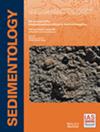中新世莱瓦奇山内盆地(塞尔维亚中部)构造诱发的石灰华沉积
IF 2.8
2区 地球科学
Q1 GEOLOGY
引用次数: 0
摘要
洞石是陆相碳酸盐岩,通常与伸展盆地和横断盆地的断层活动有关。断层是富含碳酸盐的流体上升和混合的通道,热和流星二氧化碳的输入促进了地表的石灰华沉淀。因此,石灰华演替为断层、沉积环境、流体流动和气候提供了关键的制约因素。这项研究的重点是中新世勒瓦奇盆地的石灰华演替,该盆地位于迪纳拉山脉和喀尔巴阡山脉最南端的交界处,是摩拉瓦走廊的边缘盆地。对这些洞穴进行了详细的沉积学、地质年代(U-Pb 年龄、激光烧蚀-电感耦合等离子体-质谱法)和结构分析,以重建热液哺育系统的演变过程。此外,还利用这些数据来了解富含热生成二氧化碳和陨石二氧化碳的流体交替流动以及列瓦奇盆地石灰华沉淀的控制因素,并最终阐明盆地演化的后期阶段。在演替中区分了四个面系,即石灰华斜坡、石灰华山脊、石灰华平地和受河流影响的石灰华平地。研究结果表明,石灰华沉积受到西北/西南和东北/东南正断层阵列的控制。稳定同位素数据显示,δ13C 值为正值(δ18O 为负值),在远端和地层较年轻的沉积物中转为负值,这意味着深层热液与流星水混合后被稀释。最后,洞石沉积产生了新的 U-Pb 年龄,约为 14 Ma,表明迪纳里德斯山脉其他山间盆地已知的中新世扩展阶段最远到达了东部的列瓦奇盆地和莫拉瓦走廊。本文章由计算机程序翻译,如有差异,请以英文原文为准。
Tectonically induced travertine deposition in the Middle Miocene Levač intramountain basin (Central Serbia)
Travertines are terrestrial carbonates that are commonly associated with fault activity in extensional and transtensional basins. The faults serve as conduits for the rise and mixing of carbonate enriched fluids with thermal and meteoric CO2 inputs promoting travertine precipitation at the surface. Therefore, travertine successions provide key constrain on the faulting, depositional environments, fluid flow and climate. This work focuses on the travertine succession in the Miocene Levač Basin, the marginal basin of the Morava Corridor situated at the junction of the Dinarides and the southernmost Carpathians. Detailed sedimentological, geochronological (U-Pb age, laser ablation – inductively coupled plasma – mass spectrometry) and structural analyses of the travertines are used to reconstruct the evolution of the feeding hydrothermal system. Furthermore, these data were used to understand the controlling factors governing alternation of fluid flows enriched in thermally generated and meteoric CO2, and precipitation of travertines in Levač Basin, and finally to elucidate the late stage of basin evolution. Four facies associations are distinguished within the succession, i.e. travertine slope, ridge, flat, and travertine flat under the fluvial influence. The results demonstrated that travertine deposition was controlled by north-west/south-west and north-east/south-east normal fault arrays. Stable isotope data show positive δ13C values (with δ18O being negative) shifting to negative in the distal and stratigraphically younger deposits implying dilution of deep hydrothermal fluids by mixing with meteoric waters. Finally, travertine deposits yielded a new U-Pb age of ca 14 Ma indicating that the Middle Miocene extensional phase known from other intermountain basins in the Dinarides reached as far east as the Levač Basin and Morava Corridor.
求助全文
通过发布文献求助,成功后即可免费获取论文全文。
去求助
来源期刊

Sedimentology
地学-地质学
CiteScore
8.20
自引率
11.40%
发文量
94
审稿时长
6-12 weeks
期刊介绍:
The international leader in its field, Sedimentology publishes ground-breaking research from across the spectrum of sedimentology, sedimentary geology and sedimentary geochemistry.
Areas covered include: experimental and theoretical grain transport; sediment fluxes; modern and ancient sedimentary environments; sequence stratigraphy sediment-organism interaction; palaeosoils; diagenesis; stable isotope geochemistry; environmental sedimentology
 求助内容:
求助内容: 应助结果提醒方式:
应助结果提醒方式:


